Release date: 2018-06-19
Recently, the Sinisa Vukelic and Chao Wang teams from Columbia University have made revolutionary progress in non-invasive treatment of myopia. They use a femtosecond laser with extremely high oscillating frequency to selectively change the curvature of a specific part of the cornea without destroying the cornea. For the first time, it achieves the goal of non-invasive non-invasive permanent correction of myopia in patients.
Their important research results were published in the international top journal Nature Photonics (IF: 37.852) [1]. Chinese scientist Chao Wang, who joined Vukelic Lab in 2013, is the first author and co-directed author.
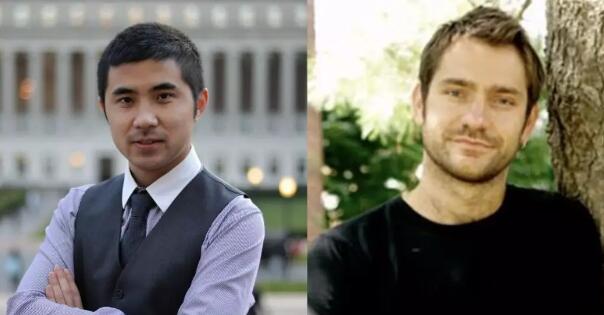
Chao Wang and Sinisa Vukelic
To clarify how powerful this new technology is, I have to introduce you to the main reasons for myopia and the current treatments.
Ok, let me bring everyone together to watch the movie and explain the above two questions.
Under normal circumstances, when we look at an object, the light reflected by the object passes through the cornea, through the pupil, through the lens, through the vitreous, and finally to our retina. We can clearly see that the object in front of us is paralyzed.
However, for people with myopia, the light from the object converges before reaching the retina, so the objects we see are ambiguous.
The main reason, I will only introduce two common ones here.
The first is that the curvature of the cornea has changed (a simple understanding is that the original cornea has become steep).
Another reason is that the eye axis of the eyeball has become larger. This is like a projector that was originally cast on a wall 2 meters away, but suddenly someone moved the projector to a distance of 3 meters from the wall. If you pay attention, you will find that those with high myopia, the eyeball is convex, which is the performance of the eye axis becomes larger.
Based on this, inventors have invented glasses very early to correct vision.
If you feel that the glasses on your nose don't look good or affect your work, then you can also choose contact lenses.
Then if wearing contact lenses is not suitable?
There is also a way for scientists to carve your cornea into glasses.
Yes, the current popular femtosecond laser myopia surgery is one of them.
Take a look at how the doctor used the laser to engrave the patient's cornea.

The top four procedures from left to right are: radial keratotomy (RK), excimer laser keratectomy (PRK), excimer laser epithelial keratomileusis (LASEK), excimer laser in situ cornea Elimination surgery (LASIK). It is said that when the laser is engraving, there will be a string of light and a little burning odor.
How about, after reading it, I feel that I should protect my eyes.
These commonly used methods, although immediate and effective, have a high risk, and some patients have permanent blindness after surgery. And this surgery is also limited by personal corneal conditions, if the patient's cornea is thin, or other diseases such as dry eye, the above treatment may not be suitable.
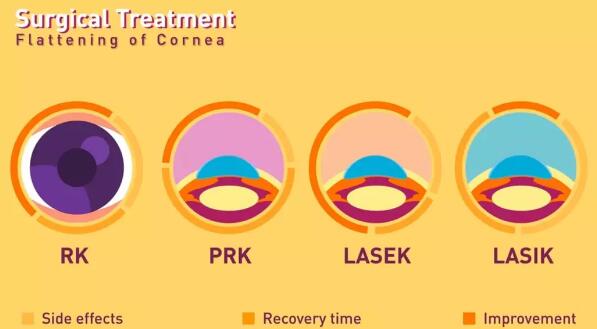
Side effects, recovery time, and efficacy comparison of the four therapies
Then, the advantages of the technology invented by Sinisa Vukelic and Chao Wang are highlighted.
The cornea is not cut and the cornea is not vaporized. The structure of the cornea is changed directly by a femtosecond oscillating laser.
In fact, the femtosecond oscillating lasers used by Sinisa Vukelic and Chao Wang have extremely low energy and extremely high oscillating frequency. In the irradiated cornea area, the water molecules inside will ionize, generating reactive oxygen species, active oxygen and collagen in the cornea. The protein reacts to form new chemical bonds or chemical crosslinks. This subtly changes the structure of the cornea, changing the curvature of the cornea without damaging the cornea.
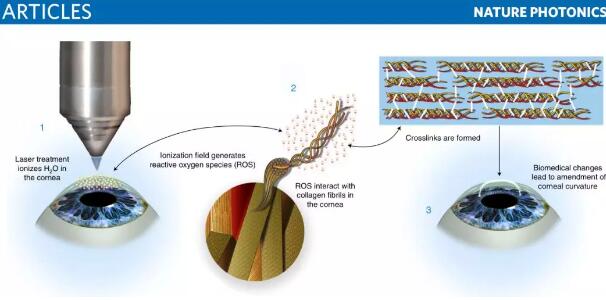
Healing
This technology has been successfully tested on pig eyeballs and rabbits. And it can not only treat myopia, but also treat hyperopia and astigmatism.
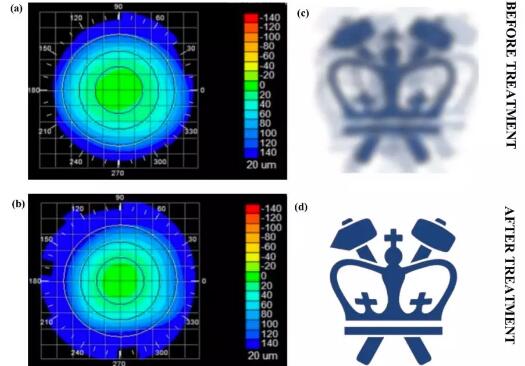
Corneal topography before and after treatment (a, b): warm tones indicate steeper areas, cool tones indicate flatter areas, and after treatment (b) corneal curvature is significantly reduced.
Retinal imaging effects before and after treatment (c, d): before treatment (c) can not see clearly, after treatment (d) is very clear
It is reported that the Vukelic team plans to start clinical trials at the end of 2018 [2]. At the same time, they are also exploring more personalized treatments.
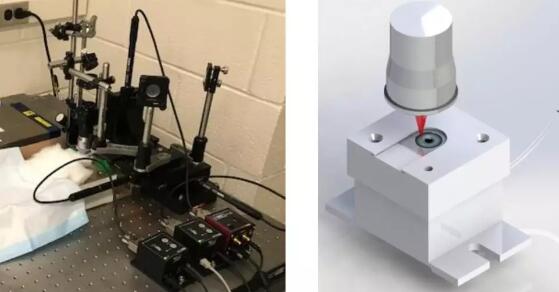
Engineering machine (left) and ideal commercial equipment (right)
According to the latest research report of the World Health Organization, there are currently as many as 600 million patients with myopia in China. Among them, high school students and college students have more than 70% of myopia, ranking first in the world. Even primary school students' nearsightedness is almost 40%.
In any case, I hope that everyone can protect their eyes, especially in the era when electronic screens are becoming more and more popular, even if it is nearsighted, and then the commercialization of technology by Sinisa Vukelic and Chao Wang.
Source: Singularity Network (micro signal geekheal_com)
Podiatry Products,Podiatry Equipment,Single Use Podiatry Instruments,Disposable Podiatry Instruments
ZHEJIANG FOMOS MEDICAL TECHNOLOGY CO.,LTD. , https://www.ifomos.com